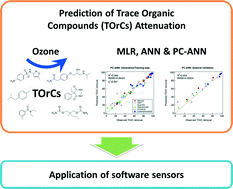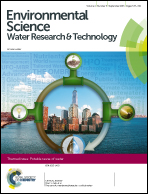Modeling approaches to predict removal of trace organic compounds by ozone oxidation in potable reuse applications†
Abstract
Realized and potential threats of water scarcity due in part to global climate change have increased the interest in potable reuse of municipal wastewater. Recalcitrant trace organic compounds (TOrCs), including pharmaceuticals and endocrine disrupting compounds in wastewater are often not efficiently removed by conventional wastewater treatment processes. Ozone application has been demonstrated to be a highly efficient oxidation process to attenuate TOrCs. However, operation of ozone oxidation can be challenging in wastewater due to variations in water quality that can impact critical control points through fluctuations in ozone demand/decay. Therefore, this study implemented three explanatory modeling techniques including multiple linear regression (MLR), artificial neutral network (ANN), and PC (principal component)-ANN to predict TOrCs removal by ozone oxidation in a secondary wastewater effluent. All the developed models displayed good agreements between the predicted TOrCs removal and the observed TOrCs removal with the explanatory variables (input variables) of ozone dose, total organic carbon (TOC) concentration, and rate constants of ozone and ˙OH. PC-ANN displayed the highest predictive power in the external validation step (R2 = 0.934) successively followed by ANN (R2 = 0.914) and MLR (R2 = 0.758). Based on the MLR model equation and the result of sensitivity analysis of the ANN model, TOC was found to have negligible effects on the TOrCs removal in a given water quality. Despite the predictive power of the ANN model, possible overfitting remains to be solved since the cross validation coefficient (q2) value calculated by the leave-one-out cross validation was not sufficient to ensure model predictive power. In contrast, the PC-ANN model was found to be robust across the scenarios applied. This study provides a guideline for software sensors to control ozone treatment processes in regards to TOrC oxidation and likely can be adapted to monitor disinfection as well.

- This article is part of the themed collection: Potable Reuse of Water

 Please wait while we load your content...
Please wait while we load your content...